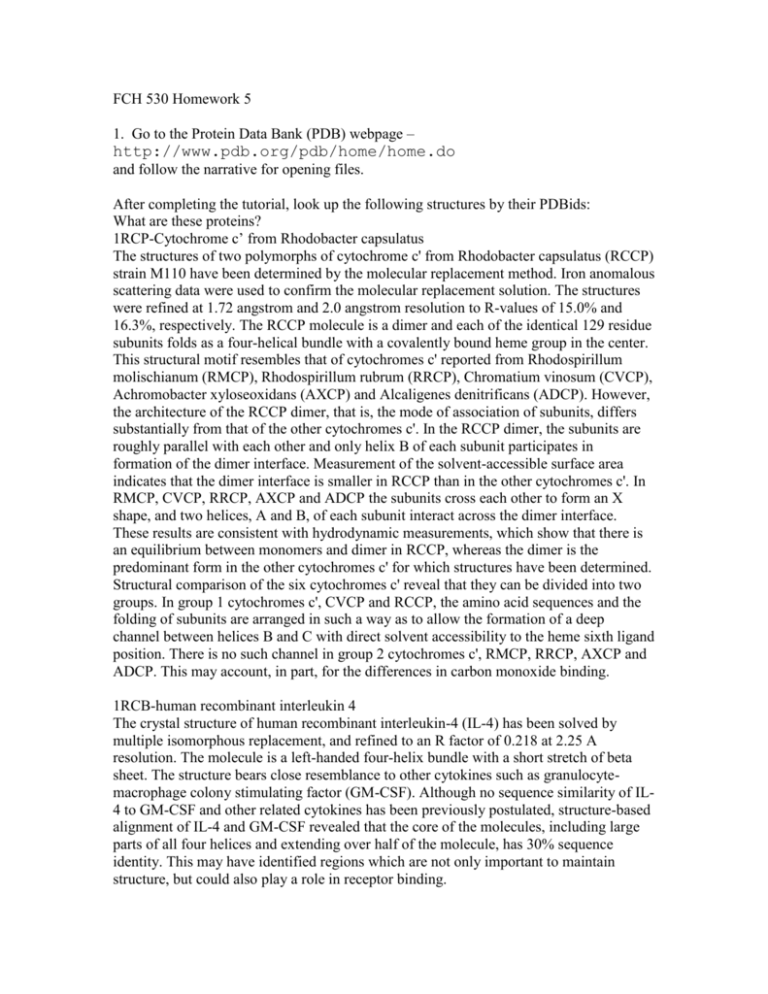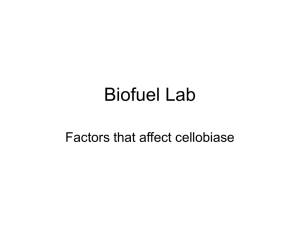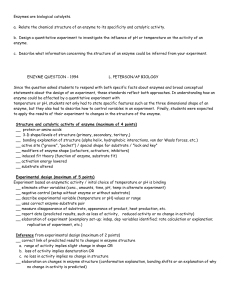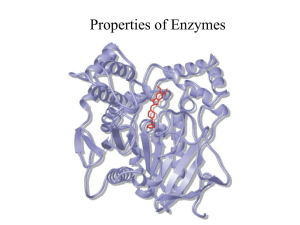FCH 530 Homework 1
advertisement

FCH 530 Homework 5 1. Go to the Protein Data Bank (PDB) webpage – http://www.pdb.org/pdb/home/home.do and follow the narrative for opening files. After completing the tutorial, look up the following structures by their PDBids: What are these proteins? 1RCP-Cytochrome c’ from Rhodobacter capsulatus The structures of two polymorphs of cytochrome c' from Rhodobacter capsulatus (RCCP) strain M110 have been determined by the molecular replacement method. Iron anomalous scattering data were used to confirm the molecular replacement solution. The structures were refined at 1.72 angstrom and 2.0 angstrom resolution to R-values of 15.0% and 16.3%, respectively. The RCCP molecule is a dimer and each of the identical 129 residue subunits folds as a four-helical bundle with a covalently bound heme group in the center. This structural motif resembles that of cytochromes c' reported from Rhodospirillum molischianum (RMCP), Rhodospirillum rubrum (RRCP), Chromatium vinosum (CVCP), Achromobacter xyloseoxidans (AXCP) and Alcaligenes denitrificans (ADCP). However, the architecture of the RCCP dimer, that is, the mode of association of subunits, differs substantially from that of the other cytochromes c'. In the RCCP dimer, the subunits are roughly parallel with each other and only helix B of each subunit participates in formation of the dimer interface. Measurement of the solvent-accessible surface area indicates that the dimer interface is smaller in RCCP than in the other cytochromes c'. In RMCP, CVCP, RRCP, AXCP and ADCP the subunits cross each other to form an X shape, and two helices, A and B, of each subunit interact across the dimer interface. These results are consistent with hydrodynamic measurements, which show that there is an equilibrium between monomers and dimer in RCCP, whereas the dimer is the predominant form in the other cytochromes c' for which structures have been determined. Structural comparison of the six cytochromes c' reveal that they can be divided into two groups. In group 1 cytochromes c', CVCP and RCCP, the amino acid sequences and the folding of subunits are arranged in such a way as to allow the formation of a deep channel between helices B and C with direct solvent accessibility to the heme sixth ligand position. There is no such channel in group 2 cytochromes c', RMCP, RRCP, AXCP and ADCP. This may account, in part, for the differences in carbon monoxide binding. 1RCB-human recombinant interleukin 4 The crystal structure of human recombinant interleukin-4 (IL-4) has been solved by multiple isomorphous replacement, and refined to an R factor of 0.218 at 2.25 A resolution. The molecule is a left-handed four-helix bundle with a short stretch of beta sheet. The structure bears close resemblance to other cytokines such as granulocytemacrophage colony stimulating factor (GM-CSF). Although no sequence similarity of IL4 to GM-CSF and other related cytokines has been previously postulated, structure-based alignment of IL-4 and GM-CSF revealed that the core of the molecules, including large parts of all four helices and extending over half of the molecule, has 30% sequence identity. This may have identified regions which are not only important to maintain structure, but could also play a role in receptor binding. Draw toplogical diagrams for each structure identifying the amino acids at the start of new secondary structure and type of structures (see Figures 8-48 through 8-54 for examples of topological diagrams). 1RCP 1RCB 3. Describe similarities and differences between the “lock and key,” “induced fit,” and “transition-state analog” models. Lock and Key Enzyme is rigid Induced Fit Assumes continuous changes in enzyme structure due to substrate binding, does not have preformed binding site Transition-state analog active site both recognizes and orients substrate to activate it for reaction Only recognizes one substrate Can recognize multiple substrates Verified by X-ray crystallography Can recognize multiple substrates Bound, distorted substrate takes on characteristics of transition state 4. What are the main two ways enzymes are regulated? Enzymes are regulated by: I. control of the amount of enzyme available. This is dependent on the rate of synthesis of the enzyme and rate of degradation of the enzyme. II. Control of enzyme activity by conformational or structural alterations-often through allosterism. 5. What is allosterism? A change in the activity and conformation of an enzyme resulting from the binding of a compound at a site on the enzyme other than the active binding site. Give an example of proteins and how this concept works. Allosteric regulations are part of natural feedback control loops for feedback inhibition or feedforward activation of enzymatic activity. An example of a protein subject to allosteric regulation that we have looked at is the aspartate transcarbamoylase (ATCase) that catalyzes the first step in pyrimidine biosynthesis. It is inhibited by the pyrimidine nucleotide triphosphate CTP and activated by ATP (a purine containing nucleotide). CTP and ATP both bind away from the active site and can cause conformational changes in the regulatory (r) subunits of the enzyme. The activator ATP binds preferentially to the enzyme in the active or relaxed (R) state. The inhibitor CTP preferentially bind to the inactive state or tense (T) state of the enzyme. Binding of the substrates causes changes in the quaternary structure that facilitate the enzyme activity. Binding of inhibitors can hold the enzyme in a less or inactive state that is unfavorable for the reaction to occur or for substrates to bind. Binding of activators can hold the enzyme in an active state that is favorable for the reaction to occur or for substrate binding. 6. What are the six classes of enzymes and what reactions do they catalyze? 1. Oxidoreductases - oxidation-reduction reactions 2. Transferases - Transfer of functional groups 3. Hydrolases - Hydrolysis reactions 4. Lyases - group elimination to form double bonds 5. Isomerases - Isomerizations (bond rearrangements) 6. Ligases - bond formation coupled with ATP hydrolysis 7. What is the difference between a cofactor and coenzyme? Give an example of each as they relate to biochemistry. Cofactors are required additives for some enzymes for assisting with the catalysis of oxidation-reduction reactions and many types of group transfer processes. They are nonprotein chemical compounds. Examples of cofactors are metal ions, coenzymes, NADH, prosthetic groups like heme, and nucleotides. Coenzymes are a subset of cofactors that are loosely bound to the enzyme and have organic properties. Examples of coenzymes are vitamin-derived cofactors such as thiamine pyrophosphate, biotin, etc. 8. For the following cofactors, what type of reactions do they help catalyze Biotin aids in carboxylation reactions (CO2 fixation) Cobalamine (B12) coenzymes-aids in alkylation reactions (methylation) Coenzyme A - acyl transfer (TCA cycle) Flavin (vitamin B2) aids in oxidation reduction reactions (nitrate reductase) Lipoic acid - acyl transfers via oxidation reduction processes Nicotinamide coenzymes - NAD+ independent co-substrates for redox reactions Pyridoxal (B6) aids in amino group transfers (provides aldehyde functional group) Tetrahydrofolate- one carbon transfers Thiamine pyrophosphate (B1)- aids in aldehyde transfers and alpha-keto acids decarboxylations. Answer the following true or false. If false, explain why. a. The initial rate of an enzyme-catalyzed reaction is independent of substrate concentration. False. The rate, v, is independent of [S] only at levels of S>>KM b. At saturating levels of substrate, the rate of an enzyme-catalyzed reaction is proportional to the enzyme concentration. True. Here v = vmax = kcat[E]0 c. The Michaelis constant KM equals the substrate concentration at which v=Vmax/2. True. d. The KM for a regulatory enzyme varies with enzyme concentration. False. The value of KM is independent of enzyme concentration or almost all enzymes. e. If enough substrate is added, the normal Vmax of an enzyme-catalyzed reaction can be attained even in the presence of a noncompetitive inhibitor. False. A noncompetitive inhibition cannot be overcome by increasing substrate concentration. f. The KM of some enzymes maybe altered by the presence of metabolites structurally unrelated to the substrate. True, these enzymes may be regulatory. g. The rate of an enzyme-catalyzed reaction in the presence of a rate-limiting concentration of substrate decreases with time. True, as the substrtae is used up, the rate decreases. h. The sigmoidal shape of the v-versus-[S] curve for some regulatory enzymes indicates that the affinity of the enzyme for substrte de creases as the substrate concentration is increased. False, the initial increasing slope of the curve shows that binding of the first substrate molecules increases the affinity of the enzyme for subsequent substrate molecules.








